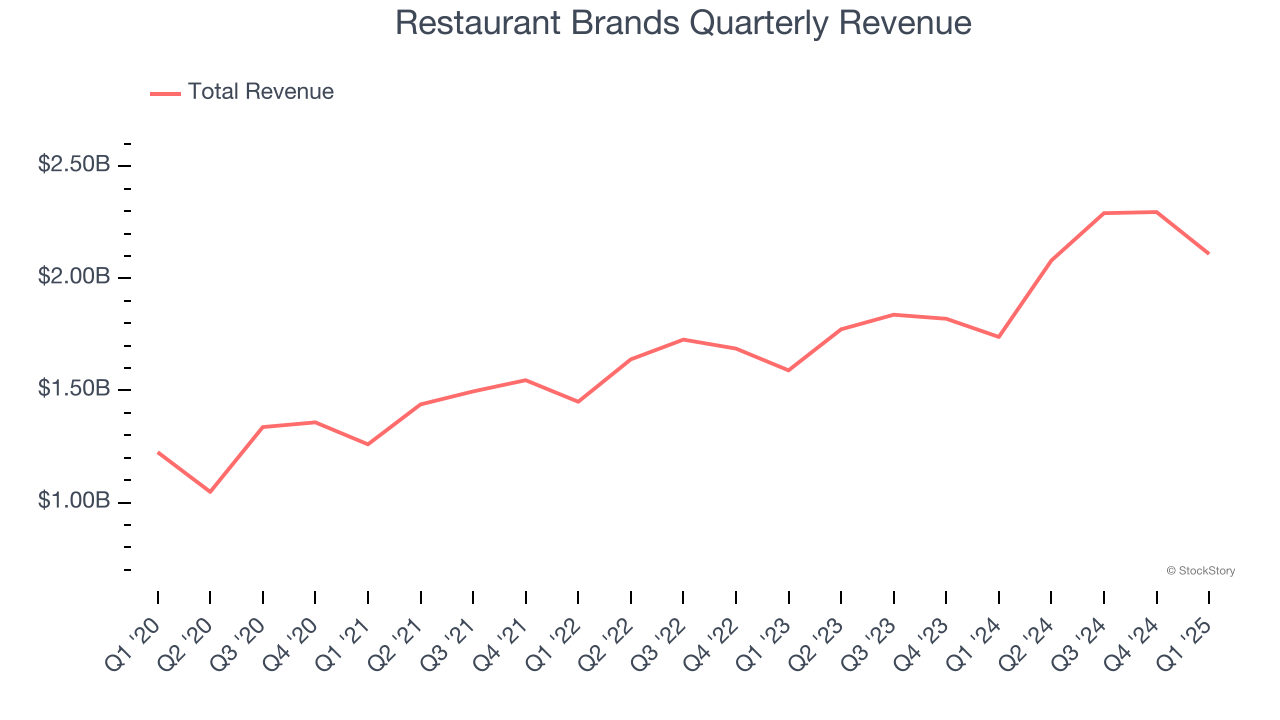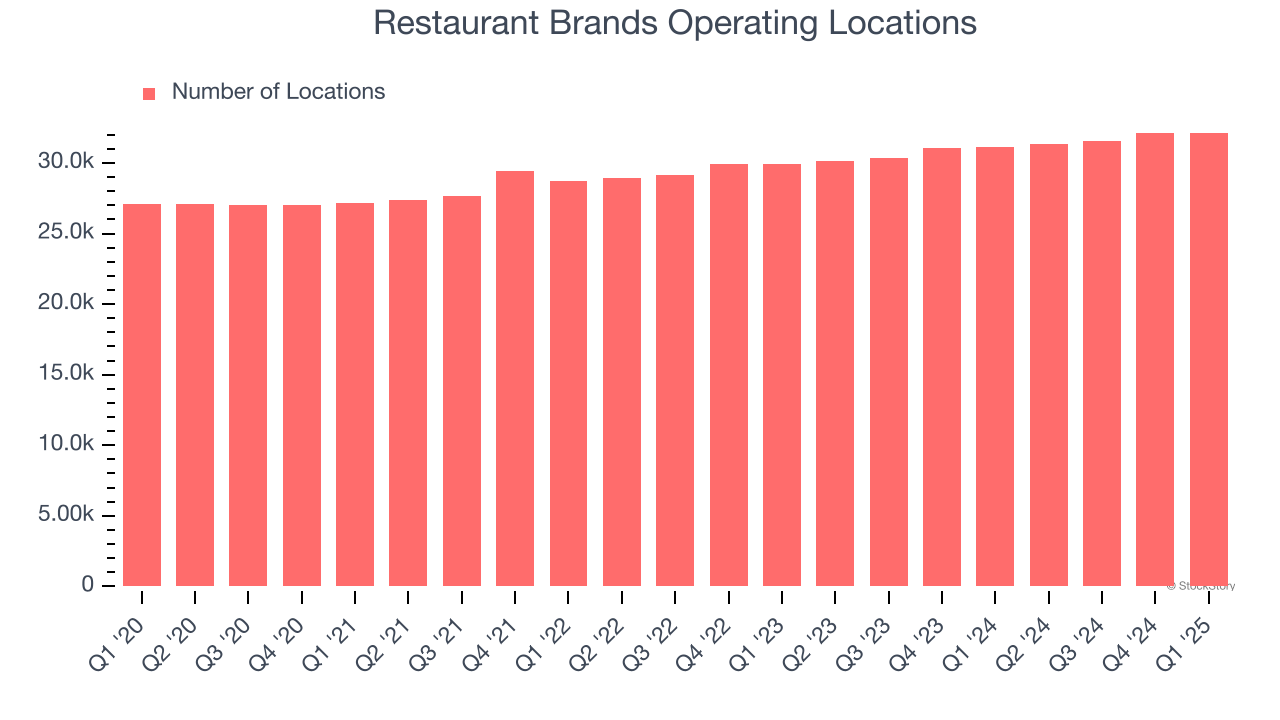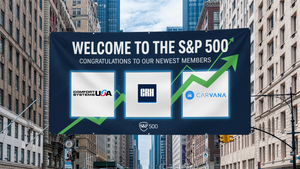
Fast-food company Restaurant Brands (NYSE: QSR) missed Wall Street’s revenue expectations in Q1 CY2025, but sales rose 21.3% year on year to $2.11 billion. Its non-GAAP profit of $0.75 per share was 4.1% below analysts’ consensus estimates.
Is now the time to buy Restaurant Brands? Find out by accessing our full research report, it’s free.
Restaurant Brands (QSR) Q1 CY2025 Highlights:
- Revenue: $2.11 billion vs analyst estimates of $2.15 billion (21.3% year-on-year growth, 1.8% miss)
- Adjusted EPS: $0.75 vs analyst expectations of $0.78 (4.1% miss)
- Adjusted EBITDA: $642 million vs analyst estimates of $671.5 million (30.4% margin, 4.4% miss)
- Operating Margin: 20.6%, down from 31.3% in the same quarter last year
- Free Cash Flow Margin: 2.6%, down from 7% in the same quarter last year
- Locations: 32,149 at quarter end, up from 31,113 in the same quarter last year
- Same-Store Sales were flat year on year (4.6% in the same quarter last year)
- Market Capitalization: $22.24 billion
Company Overview
Formed through a strategic merger, Restaurant Brands International (NYSE: QSR) is a multinational corporation that owns three iconic fast-food chains: Burger King, Tim Hortons, and Popeyes.
Sales Growth
A company’s long-term sales performance can indicate its overall quality. Any business can experience short-term success, but top-performing ones enjoy sustained growth for years.
With $8.78 billion in revenue over the past 12 months, Restaurant Brands is one of the most widely recognized restaurant chains and benefits from customer loyalty, a luxury many don’t have. Its scale also gives it negotiating leverage with suppliers, enabling it to source its ingredients at a lower cost.
As you can see below, Restaurant Brands’s 8.5% annualized revenue growth over the last six years (we compare to 2019 to normalize for COVID-19 impacts) was decent as it opened new restaurants and increased sales at existing, established dining locations.

This quarter, Restaurant Brands generated an excellent 21.3% year-on-year revenue growth rate, but its $2.11 billion of revenue fell short of Wall Street’s high expectations.
Looking ahead, sell-side analysts expect revenue to grow 5.9% over the next 12 months, a slight deceleration versus the last six years. This projection is underwhelming and indicates its menu offerings will face some demand challenges. At least the company is tracking well in other measures of financial health.
Software is eating the world and there is virtually no industry left that has been untouched by it. That drives increasing demand for tools helping software developers do their jobs, whether it be monitoring critical cloud infrastructure, integrating audio and video functionality, or ensuring smooth content streaming. Click here to access a free report on our 3 favorite stocks to play this generational megatrend.
Restaurant Performance
Number of Restaurants
The number of dining locations a restaurant chain operates is a critical driver of how quickly company-level sales can grow.
Restaurant Brands sported 32,149 locations in the latest quarter. Over the last two years, it has opened new restaurants at a rapid clip by averaging 3.8% annual growth, among the fastest in the restaurant sector. Furthermore, one dynamic making expansion more seamless is the company’s franchise model, where franchisees are primarily responsible for opening new restaurants while Restaurant Brands provides support.
When a chain opens new restaurants, it usually means it’s investing for growth because there’s healthy demand for its meals and there are markets where its concepts have few or no locations.

Same-Store Sales
A company's restaurant base only paints one part of the picture. When demand is high, it makes sense to open more. But when demand is low, it’s prudent to close some locations and use the money in other ways. Same-store sales is an industry measure of whether revenue is growing at those existing restaurants and is driven by customer visits (often called traffic) and the average spending per customer (ticket).
Restaurant Brands’s demand has been spectacular for a restaurant chain over the last two years. On average, the company has increased its same-store sales by an impressive 4% per year. This performance suggests its rollout of new restaurants is beneficial for shareholders. We like this backdrop because it gives Restaurant Brands multiple ways to win: revenue growth can come from new restaurants or increased foot traffic and higher sales per customer at existing locations.

In the latest quarter, Restaurant Brands’s year on year same-store sales were flat. This was a meaningful deceleration from its historical levels. We’ll be watching closely to see if Restaurant Brands can reaccelerate growth.
Key Takeaways from Restaurant Brands’s Q1 Results
Both revenue and EPS missed. Overall, this was a softer quarter. The stock remained flat at $68.25 immediately after reporting.
So should you invest in Restaurant Brands right now? We think that the latest quarter is only one piece of the longer-term business quality puzzle. Quality, when combined with valuation, can help determine if the stock is a buy. We cover that in our actionable full research report which you can read here, it’s free.





